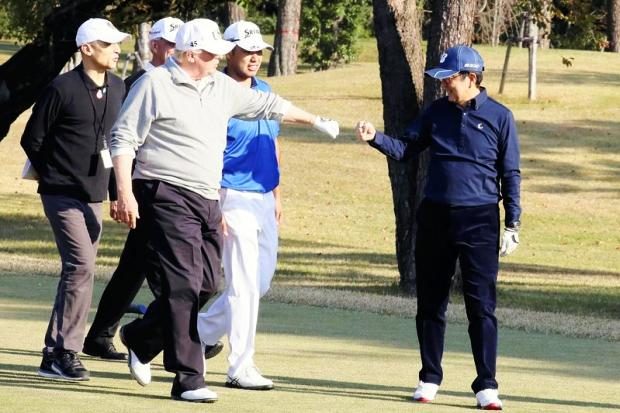Japan, US leaders have ‘extraordinary’ relationship

US President Donald Trump (front left) reacts to Prime Minister Shinzo Abe’s good shot in Kawagoe, Saitama Prefecture, on Sunday, Nov. 5, 2017. Professional golfer Hideki Matsuyama is seen between the two leaders. (Photo courtesy of the Japan Cabinet Public Relations Office)
As US President Donald Trump started his first visit to Japan on Sunday, Prime Minister Shinzo Abe treated him to golf and a teppanyaki grill dinner. The friendly relationship between Abe and Trump stands out among world leaders, as issues pile up including the increasingly tense situation involving North Korea and trade.
In relaxed mood
Abe welcomed Trump at a golf course in Kawagoe, Saitama Prefecture, and gave him a white cap as a gift at lunch.
The two leaders signed the cap, embroidered with a message in gold thread saying “MAKE ALLIANCE EVEN GREATER.” According to sources, during a round of golf with professional golfer Hideki Matsuyama, Abe sank his tee shot on the eighth hole. When Abe began walking, Trump stopped him, saying, “Shinzo,” and gave him a fist bump.
When Abe made a bunker shot and hit the ball close to the pin, Trump expressed surprise, asking if he was really the prime minister of Japan. All three shot par on the hole. Trump was in a good mood from start to finish, and told Abe he was doing well, just as expected from the recent House of Representatives election victory.
Trump usually uses a golf cart. However, Trump walked on the fairway on Sunday with Abe while having intense discussions about North Korea and other issues.
Article continues after this advertisementAt a dinner party, Abe, Trump, first lady Melania Trump, and Abe’s wife, Akie, sat side by side in that order, while the two leaders spent most of the time talking to each other, according to sources close to the Japanese government. Ahead of the dinner party, Trump said the “relationship is really extraordinary… I don’t think we’ve ever been closer to Japan than we are right now.”
Article continues after this advertisementAccording to sources, Abe later said to people close to him, “It’s important to show such relations to the rest of the world.”
Strong Japan-US alliance
Through Trump’s latest visit to Japan, Abe intends to further develop a personal relationship with him and present a strong Japan-U.S. alliance to the international community. He also aims to increase Japan’s diplomatic and security presence.
The two leaders have had a number of talks since Trump took office. Just after becoming president, Trump was not very interested in North Korea, but Abe gave him detailed explanations about the issue at the Japan-U.S. summit meeting in February. This led to Trump’s shift toward a tougher stance on North Korea.
“There is no doubt that the relationship between Abe and Trump is extraordinary compared to relations between past leaders of Japan and the United States,” a senior official at the Foreign Ministry said.
US trade deficit
Abe is deepening the relationship with Trump, but he has so far failed to improve ties with China, which holds the key to resolving the issue of North Korea. Relations with South Korea remain strained. There is concern within the government and the ruling parties about Abe’s excessive inclination toward Trump.
“We should also recognize the fact that the Trump administration is not fully trusted by the American people,” Shigeru Ishiba, the former secretary general of the ruling Liberal Democratic Party, said to reporters in Tokyo on Sunday. Ishiba said it is important to strengthen Japan-China and Japan-South Korea relations, which are weaker than relations between Japan and Russia, and between Japan and the United States, in order to resolve the North Korean issue.
Also, Japan hopes to promote multilateral trade agreements in the economic field, but it is struggling to predict the moves of the United States. In the second round of the Japan-US Economic Dialogue held in October, U.S. Vice President Mike Pence indicated Washington’s “strong interest” in a Japan-US free trade agreement to Deputy Prime Minister and Finance Minister Taro Aso.
During the latest trip to Japan, Trump may mention a Japan-US FTA as well as the reduction of the U.S. trade deficit with Japan. The Japanese government hopes to accelerate negotiations on the Trans-Pacific Partnership free trade agreement, which involves 11 countries excluding the United States, and an economic partnership agreement with the European Union, aiming to bring the United States back to multilateral trade frameworks.